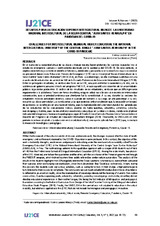Mostrar el registro sencillo del ítem
Desafíos para la Educación Superior Intercultural Bilingüe. La universidad Nacional Intercultural de la Selva Central “Juan Santos Atahualpa” en pandemia del COVID-19
| dc.contributor.author | Landeo Minaya, Karina Lisbeth | |
| dc.date.accessioned | 2023-02-23T12:27:22Z | |
| dc.date.available | 2023-02-23T12:27:22Z | |
| dc.date.issued | 2022 | |
| dc.identifier.issn | 2444-3921 | |
| dc.identifier.uri | http://hdl.handle.net/10396/24773 | |
| dc.description.abstract | En el marco de la modalidad virtual de las clases y trabajo remoto, fueron profundos los cambios impuestos tras el estado de emergencia sanitaria y confinamiento decretado por la pandemia del COVID-19. En este contexto, el objetivo de este trabajo consiste en identificar fortalezas, debilidades y prospectivas en la enseñanza bajo la modalidad no presencial denominada ‘Educación Remota de Emergencia’ (ERE) en la Universidad Nacional Intercultural de la Selva Central “Juan Santos Atahualpa” (UNISCJSA), en Perú. La metodología, se ciñe al enfoque cualitativo con una muestra de 66 estudiantes de un total de 140 de la Escuela Profesional de Educación Intercultural Bilingüe (EPEIB). Entre los principales resultados, se destaca dos fases de la ERE, una para enfrentar la cuarentena y la otra, con la asistencia del gobierno peruano a través del programa PMESUT, el cual capacitó a los docentes de las universidades públicas bajo ciertos parámetros. El análisis de los resultados en los estudiantes, destacan que un 30%ingresaron regularmente a la plataforma Teams de forma sincrónica, ninguno activó sus cámaras al momento de intercambiar comunicación, pues el principal problema que afrontaron fue la conectividad. A su vez, durante las sesiones los estudiantes realizan actividades diversas, como el cuidado de menores a su cargo, un alto porcentaje a su vez, escuchó sus clases por celular. Las conclusiones a las que podemos arribar establecen que, la educación en tiempos de pandemia se ve reflejada en una realidad incierta, pues la reproducción del saber desnaturalizó los aprendizajes de los estudiantes de las comunidades nativas, jóvenes de habla quechua, ashaninka, asheninka, yanesha, nomatsigenga y kakinte, pues no desarrollaron experiencias educativas en su idioma materno, siendo este el primer indicador del bilingüismo y fundamento pedagógico según él Diseño Básico Curricular Nacional de la Formación Inicial Docente del Programa de estudios de Educación Intercultural Bilingüe (2018). Finalmente, la UNISCJSA en este periodo no estuvo adaptada a la educación en la modalidad virtual, sino que lo aplicado fue la (ERE) que, no incluyó la innovación tecnológica y pedagógica. | es_ES |
| dc.description.abstract | Within the framework of the virtual modality of classes and remote work, the changes imposed after the state of health emergency and confinement decreed by the COVID-19 pandemic were profound. In this context, the objective of this work is to identify strengths, weaknesses and prospects in teaching under the non-face-to-face modality called 'Remote Emergency Education' (ERE) at the National Intercultural University of the Central Jungle "Juan Santos Atahualpa" (UNISCJSA), in Peru. The methodology adheres to the qualitative approach with a sample of 66 students out of total of 140 from the Professional School of Bilingual Intercultural Education (EPEIB). Among the main results, two phases of the ERE stand out, one to face the quarantine and the other, with the assistance of the Peruvian government through the PMESUT program, which trained teachers from public universities under certain parameters. The analysis of the results in the students highlights that 30% regularly entered the Teams platform synchronously, none of them activated their cameras when exchanging communication, since the main problem they faced was connectivity. In turn, during the sessions the students carry out various activities, such as caring for minors in their charge, a high percentage in turn, listened to their classes by cell phone. The conclusions we can reach establish that education in times of pandemic is reflected in an uncertain reality, since the reproduction of knowledge denatured the learning of students from nativecommunities, Quechua-speaking youth, ashaninka, asheninka, yanesha, nomatsigenga and kakinte, since they did not develop educational experiences in their mother tongue, this being the first indicator of bilingualism and pedagogical foundation according tothe National Curriculum Basic Design of the Initial Teacher Training of the Bilingual Intercultural Education Study Program (2018). Finally, the UNISCJSA in this period was not adapted to education in the virtual modality, but what was applied was the (ERE) that did not include technological and pedagogical innovation. | es_ES |
| dc.format.mimetype | application/pdf | es_ES |
| dc.language.iso | spa | es_ES |
| dc.publisher | Universidad de Córdoba, UCOPress | es_ES |
| dc.rights | https://creativecommons.org/licenses/by-nc-nd/4.0/ | es_ES |
| dc.source | International Journal for 21st Century Education 9 (1), 55-72 (2022) | es_ES |
| dc.subject | Universidad intercultural | es_ES |
| dc.subject | Educación Remota de Emergencia | es_ES |
| dc.subject | Covid-19 | es_ES |
| dc.subject | Pandemia | es_ES |
| dc.subject | Intercultural University | es_ES |
| dc.subject | Virtual mode | es_ES |
| dc.subject | Remote Emergency Education | es_ES |
| dc.subject | Pandemic | es_ES |
| dc.title | Desafíos para la Educación Superior Intercultural Bilingüe. La universidad Nacional Intercultural de la Selva Central “Juan Santos Atahualpa” en pandemia del COVID-19 | es_ES |
| dc.title.alternative | Challenges for Intercultural Bilingual Higher Education. The National Intercultural University of the Central Jungle “Juan Santos Atahualpa” in the COVID-19 pandemic | es_ES |
| dc.type | info:eu-repo/semantics/article | es_ES |
| dc.relation.publisherversion | http://www.uco.es/ucopress/ojs/index.php/ij21ce/index | es_ES |
| dc.rights.accessRights | info:eu-repo/semantics/openAccess | es_ES |

